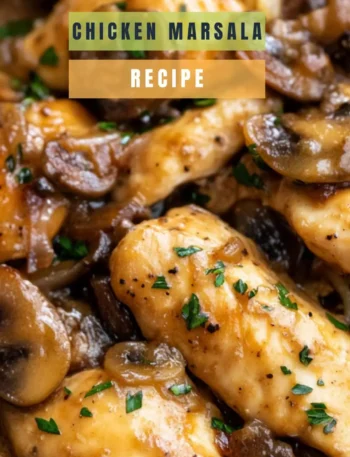Let’s get this party started. When it comes to pairing dishes, every aspect counts—from drinks to sides. For shrimp in Thai coconut sauce, the tropical, creamy flavors need companions that balance them out. Here are some great options:
- Steamed Jasmine Rice: Fluffy, fragrant, and capable of soaking up the vibrant sauce. Imagine a bite of shrimp followed by a scoop of rice. It’s pure bliss.
- Crispy Spring Rolls: A crunchy starter that provides texture. Inside those rolls, fresh veggies and a hint of herbs make your taste buds sing.
- Cilantro Lime Quinoa: This healthy alternative to rice brings brightness and a minor tang, complementing the rich coconut flavors.
- Cold Beer or Coconut Water: To wash it down, both options fit beautifully. A cold lager or the refreshing chill of coconut water can elevate a meal that’s surely to impress.
- Thai Green Mango Salad: A zesty side that pairs well, this salad’s crunch and tartness contrast the creamy shrimp perfectly.
With this menu set, let’s dive into the wonderful world of shrimp in Thai coconut sauce.
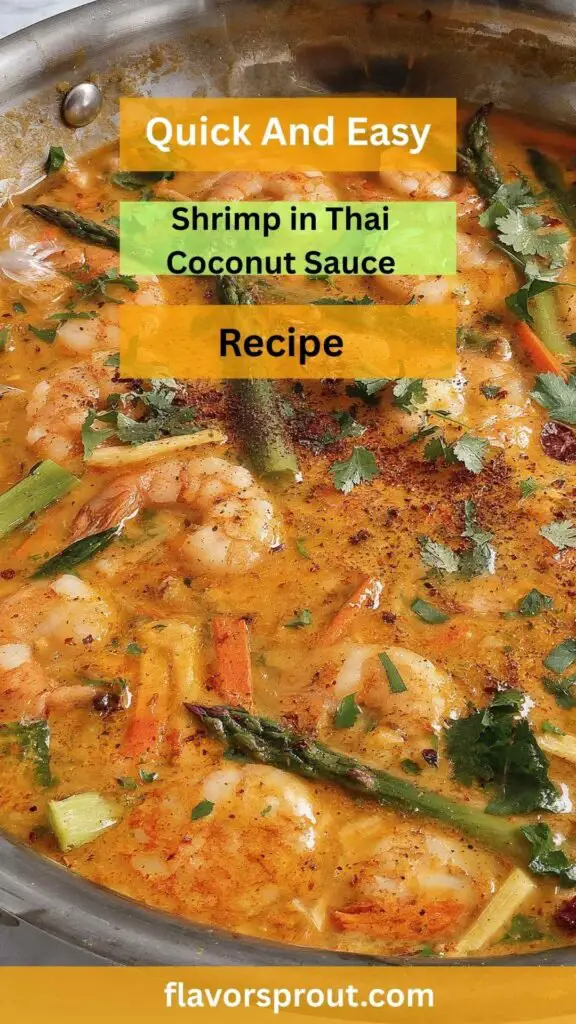
You’ll Also Like These Recipes
- Pairing Suggestions for Cheesy French Onion Soup Recipe
- Buttery Parsley Potatoes
- Gnocchi and Pomodoro Sauce Recipe
There’s something special about exploring new cuisines. My love affair with Thai food began years ago during a rather uneventful trip to a local Thai restaurant. Out came a plate filled with shrimp nestled in a luscious coconut sauce. As I took my first bite, I was hooked. The marriage of shrimp, coconut milk, and spices made my taste buds dance, and that flavor has lived rent-free in my mind ever since. Today, I want to share a recipe that packs all that flavor into your kitchen.
So, whether you’re cooking for a cozy dinner, a weekend gathering, or a weeknight treat, this Thai coconut shrimp dish promises simplicity and flair. Let’s explore the ins and outs of this delightful dish.
What is Shrimp in Thai Coconut Sauce?
Shrimp in Thai coconut sauce is a classic dish that embodies the heart of Thai cooking. It’s not just shrimp cooked in a sauce; it’s a dance of flavors and textures. Shrimp, known for its quick cooking time, partners perfectly with a sweet and spicy coconut-based sauce. The combination often includes aromatic ingredients like garlic, ginger, and scallions, creating a mix that brings warmth and vibrancy.
Truth be told, each neighborhood in Thailand might offer a unique twist on coconut shrimp, often featuring local spices or vegetables. However, the essential components—the shrimp and the coconut sauce—remain constant. This dish shines brightly on any plate and makes you feel like you’re cruising on a kayak in the tranquil waters of Thailand.
What is the Flavor Profile of This Dish?
Picture this: you take a bite, and your mouth is met with a wave of warmth. The coconut milk offers a creamy sweetness while the Thai red curry paste introduces a layer of spicy depth. The fresh ginger adds a hint of warmth without overpowering, while garlic brings in a savory note. The excitement continues with crunchy vegetables mingling in each forkful, providing not just texture but contrasting flavors.
In a nutshell, expect a fusion of:
- Creamy and Sweet: From the coconut milk.
- Savory and Umami: Brought by garlic and optional fish sauce.
- Spicy Elements: Thanks to the red curry paste and optional chili.
- Freshness and Crispiness: From the veggies mixed in, ensuring balance.
That combination is what makes this dish decidedly delicious.
Why You’ll Love This?
You might wonder, what’s so special about shrimp in Thai coconut sauce? Well, let me break it down:
- Quick Cooking Time: Ready in under 30 minutes, making it perfect for busy individuals.
- Versatile: You can swap out shrimp for chicken, tofu, or even your choice of vegetables.
- Flavor-Packed: Bold flavors mean a little goes a long way. You won’t need many ingredients to create magic.
- Nutrition Benefits: Shrimp is high in protein and low in calories, while coconut milk provides healthy fats.
This dish can fit seamlessly into any weeknight dinner or festive occasion. Trust me when I say, once you’ve made it, you’ll find yourself returning to the recipe again and again.
Ingredients
Now that I’ve whetted your appetite, here’s what you’ll need:
- 1 pound medium raw shrimp, peeled and deveined
- 2 teaspoons unrefined olive oil or avocado oil
- 4 cloves garlic, minced
- 4 scallions, chopped (whites and greens separated) or 1 medium shallot, finely diced
- 1 teaspoon freshly grated ginger
- 2 cups quick-cooking vegetables of your choice (like julienned sweet bell pepper, shredded carrots, sliced mushrooms, sliced snow peas, fresh spinach, or thinly sliced cabbage)
- 13.5 ounces canned coconut milk
- 2 tablespoons Thai red curry paste (I recommend Mekhala brand)
- ½ teaspoon sea salt, plus more to taste
- 1 small red chili, finely sliced (optional, for gentle heat)
- 1 tablespoon fish sauce (optional)
Gathering these ingredients will set you on the path to culinary success.
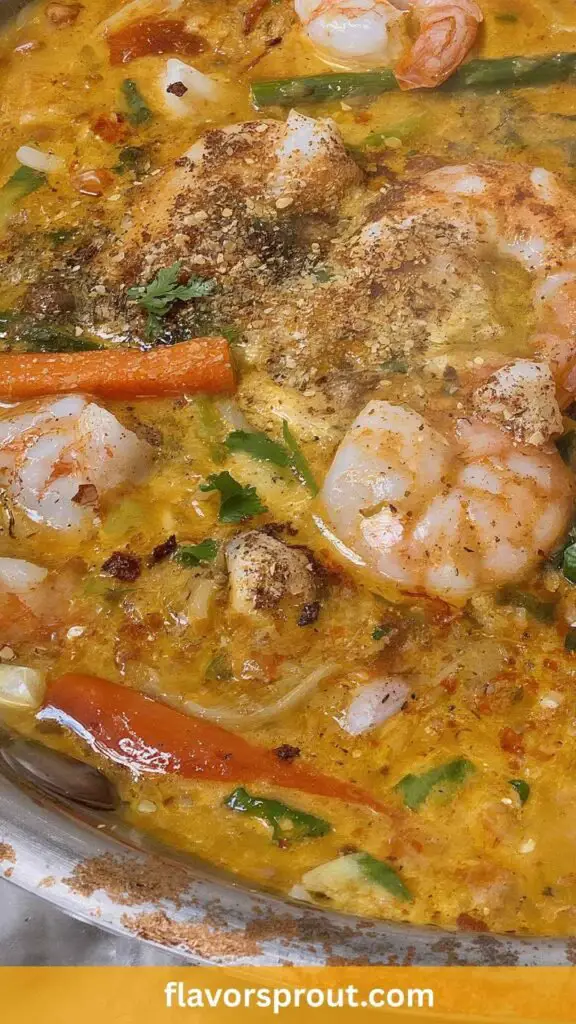
Step-by-Step Instructions
Ready to dive into cooking? Let’s embark on this journey together.
Step 1: Prepping the Shrimp
Start by rinsing the shrimp under cold water. Remove any shells or bits that don’t belong. Once cleaned, set them aside and let them dry.
Step 2: Gather Your Ingredients
Chop your vegetables, mince the garlic, and grate the ginger. Having everything prepared makes the cooking process smooth. This is the key to a calm kitchen experience!
Step 3: Heat the Oil
In a large skillet or wok, heat the olive oil over medium heat. The oil needs to shimmer but not smoke. This is where we’ll start building our flavors.
Step 4: Sauté Aromatics
Add the minced garlic, chopped scallion whites or shallot, and grated ginger to the hot oil. Sauté everything for about a minute until fragrant. Be careful not to let it burn!
Step 5: Add Vegetables
Next, throw in your quick-cooking vegetables. Stir them around to mix with the aromatics, cooking only for a few minutes until slightly tender yet still colorful. You want to keep that crunch!
Step 6: Create the Coconut Sauce
Pour in the coconut milk and add the Thai red curry paste. Stir well, blending it all together. Season with salt. If you’re adding fish sauce or that sliced chili, do it now! Bring this mixture to a simmer.
Step 7: Cook the Shrimp
Once your sauce is bubbling, add in the shrimp. They cook quickly, so stir them gently for about 3–5 minutes until they turn pink and opaque.
Step 8: Final Adjustments
Taste the sauce. If needed, sprinkle more salt or adjust the spice levels. If it’s perfect, you’re ready to serve!
Step 9: Garnish and Serve
Turn off the heat. Garnish with the greens of your scallions for a pop of color. Serve immediately over rice or on its own.
Tips and Tricks
Here’s how you can elevate your cooking game with shrimp in Thai coconut sauce:
- Fresh Ingredients: Always opt for fresh shrimp if possible. Quality matters and the taste difference is noticeable.
- Controlled Heat: Adjust the level of red curry paste depending on your tolerance for spice. Start small; you can always add more as it cooks.
- Vegetable Variety: Switch up vegetables based on what’s in season or what you have on hand.
- Make it Ahead: You can prepare the coconut sauce in advance. Just add the shrimp and veggies before serving.
- Don’t Overcook: Shrimp cooks quickly. Remove from heat as soon as they turn pink for optimal tenderness.
Nutrition Information
Here’s a quick glance at the nutritional value of this delightful dish. Keep in mind, values may vary based on exact ingredients and portion sizes:
This balanced meal is perfect for maintaining energy throughout the day.
How Can You Store This Shrimp in Thai Coconut Sauce?
If the dish is not polished off at the dinner table, don’t fret. Here’s how to store it properly:
- Refrigeration: Place leftovers in an airtight container. Store for up to 2 days. Reheat gently on the stove with a splash of coconut milk so it doesn’t dry out.
- Freezing: To freeze, ensure it’s cooled entirely before putting it in a freezer-safe container. Enjoy within 2-3 months. Thaw overnight in the fridge before reheating.
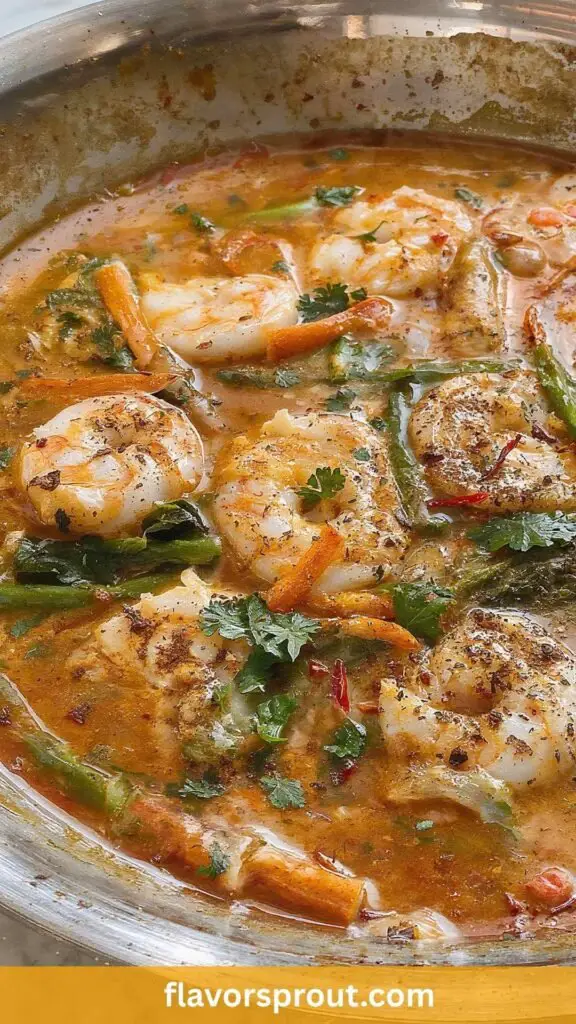
Alternative Ingredient Choices
Sometimes, you may find yourself fresh out of particular ingredients. Here are some substitutions that work well:
- Shrimp Alternatives: Chicken or Tofu – Both can be marinated and cooked similarly. Ensure chicken is fully cooked before serving.
- Coconut Milk Replacement: Almond Milk – This can be used if you like a lighter sauce, though it won’t deliver the same creaminess.
- Red Curry Paste Substitute: Yellow Curry Paste – Similar but with a different flavor profile. It adds its own unique flair!
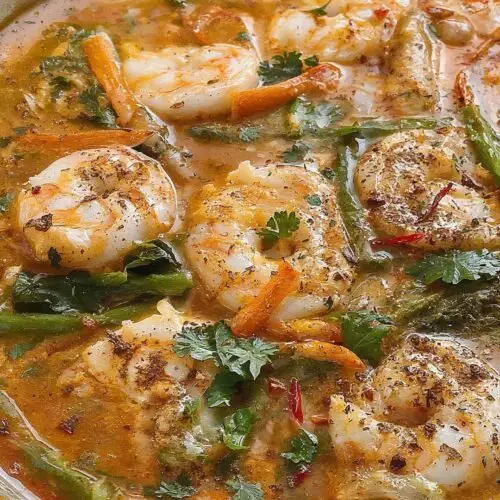
Thai Coconut Shrimp Recipe
Equipment
- Large skillet, bowl
Ingredients
- 1 pound medium raw shrimp peeled and deveined
- 2 teaspoons unrefined olive oil or avocado oil
- 4 cloves garlic minced
- 4 scallions chopped (whites and greens separated) or 1 medium shallot, finely diced
- 1 teaspoon freshly grated ginger
- 2 cups quick-cooking vegetables of your choice like julienned sweet bell pepper, shredded carrots, sliced mushrooms, sliced snow peas, fresh spinach, or thinly sliced cabbage
- 13.5 ounces canned coconut milk
- 2 tablespoons Thai red curry paste
- ½ teaspoon sea salt plus more to taste
- 1 small red chili finely sliced
- 1 tablespoon fish sauce
Instructions
Step 1: Prepping the Shrimp
- Start by rinsing the shrimp under cold water. Remove any shells or bits that don’t belong. Once cleaned, set them aside and let them dry.
Step 2: Gather Your Ingredients
- Chop your vegetables, mince the garlic, and grate the ginger. Having everything prepared makes the cooking process smooth. This is the key to a calm kitchen experience!
Step 3: Heat the Oil
- In a large skillet or wok, heat the olive oil over medium heat. The oil needs to shimmer but not smoke. This is where we’ll start building our flavors.
Step 4: Sauté Aromatics
- Add the minced garlic, chopped scallion whites or shallot, and grated ginger to the hot oil. Sauté everything for about a minute until fragrant. Be careful not to let it burn!
Step 5: Add Vegetables
- Next, throw in your quick-cooking vegetables. Stir them around to mix with the aromatics, cooking only for a few minutes until slightly tender yet still colorful. You want to keep that crunch!
Step 6: Create the Coconut Sauce
- Pour in the coconut milk and add the Thai red curry paste. Stir well, blending it all together. Season with salt. If you’re adding fish sauce or that sliced chili, do it now! Bring this mixture to a simmer.
Step 7: Cook the Shrimp
- Once your sauce is bubbling, add in the shrimp. They cook quickly, so stir them gently for about 3–5 minutes until they turn pink and opaque.
Step 8: Final Adjustments
- Taste the sauce. If needed, sprinkle more salt or adjust the spice levels. If it’s perfect, you’re ready to serve!
Step 9: Garnish and Serve
- Turn off the heat. Garnish with the greens of your scallions for a pop of color. Serve immediately over rice or on its own.
Notes
- Fresh Ingredients: Always opt for fresh shrimp if possible. Quality matters and the taste difference is noticeable.
- Controlled Heat: Adjust the level of red curry paste depending on your tolerance for spice. Start small; you can always add more as it cooks.
- Vegetable Variety: Switch up vegetables based on what’s in season or what you have on hand.
- Make it Ahead: You can prepare the coconut sauce in advance. Just add the shrimp and veggies before serving.
- Don’t Overcook: Shrimp cooks quickly. Remove from heat as soon as they turn pink for optimal tenderness.
Nutrition
Frequently Asked Questions
1. Can I make this dish vegetarian?
Absolutely! Feel free to swap shrimp with tofu or increase the amount of veggies you add. Just ensure any sauces used are plant-based.
2. What if I don’t like spicy food?
That’s okay. Reduce or omit the red curry paste and avoid the chili. You can still enjoy a delicious coconut-flavored dish!
3. How do I know when the shrimp are cooked?
Cooked shrimp turns from gray to a pink color and becomes opaque. Keep an eye on them; they only need a few minutes!
4. Can I add more vegetables?
Yes! Feel free to be creative. Broccoli, zucchini, or snap peas would work wonderfully to add color and texture.
5. What can I serve this with, besides rice?
Try serving with quinoa, couscous, or even in lettuce wraps. Each option changes the meal’s dynamics and offers a delightful twist.
Conclusion
There you have it! Shrimp in Thai coconut sauce is more than just a dish; it’s an experience waiting to unfold in your home. With its explosion of flavors and delightful preparation, you’ll enjoy every moment spent in the kitchen.
Don’t hesitate to make it your own. Experiment with your favorite veggies or kick the spice up a notch if you’re daring. This meal can shine for any occasion, bringing a taste of Thailand straight to your plate. Try it out, and who knows? It might just become a staple at your dinner table.

